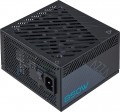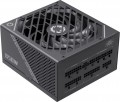Fan size
The diameter of the fan(s) in the power supply cooling system.
The large diameter allows to achieve good efficiency at relatively low RPMs, which in turn reduces noise and power consumption. On the other hand, large fans are more expensive than small ones and take up a lot of space, which affects the dimensions of the entire PSU. We also emphasize that a small fan is not yet a sign of a cheap power supply — quite advanced models can also have such equipment, in order to reduce dimensions.
As for specific diameters, the smallest value that can be found in modern consumer-grade PSUs is
80 mm. The most popular option is
120 mm, this size gives good efficiency and a relatively low noise level at a reasonable price and dimensions. Larger diameters are somewhat less common —
135 mm and
140 mm.
Fan bearing
The bearing is the piece between the rotating axle of the fan and the fixed base that supports the axle and reduces friction. The following types of bearings are found in modern fans:
— Sliding. The action of these bearings is based on direct contact between two solid surfaces, carefully polished to reduce friction. Such devices are simple, reliable and durable, but their efficiency is quite low — rolling, and even more so the hydrodynamic and magnetic principle of operation, provide much less friction.
— Rolling. They are also called "ball bearings", since the "mediators" between the axis of rotation and the fixed base are balls (less often — cylindrical rollers) fixed in a special ring. When the axis rotates, such balls roll between it and the base, due to which the friction force is very low — noticeably lower than in plain bearings. On the other hand, the design turns out to be more expensive and complex, and in terms of reliability it is somewhat inferior to both the same plain bearings and more advanced hydrodynamic devices. Therefore, although rolling bearings are quite widespread nowadays, however, in general, they are much less common than the mentioned varieties.
— Hydrodynamic. Bearings of this type are filled with a special liquid; when rotated, it creates a layer on which the moving part of the bearing slides. In this way, direct contact between hard surfaces is avoided and friction is significantly reduced compared to previous...types. Also, these bearings are quiet and very reliable. Of their shortcomings, a relatively high cost can be noted, but in fact this moment often turns out to be invisible against the background of the price of the entire system. Therefore, this option is extremely popular nowadays, it can be found in cooling systems of all levels — from low-cost to advanced.
— Magnetic centering. Bearings based on the principle of magnetic levitation: the rotating axis is "suspended" in a magnetic field. Thus, it is possible (as in hydrodynamic ones) to avoid contact between solid surfaces and further reduce friction. Considered the most advanced type of bearings, they are reliable and quiet, but expensive.
SATA
The number of SATA power connectors provided in the PSU.
Nowadays, SATA is the standard interface for connecting internal hard drives, and it is also found in other types of drives (SSD, SSHD, etc.). Such an interface consists of a data connector connected to the motherboard, and a power connector connected to the PSU. Accordingly, in this paragraph we are talking about the number of SATA power plugs provided in the PSU. This number corresponds to the number of SATA drives that can be simultaneously powered from this model.
MOLEX
The number of Molex (IDE) connectors provided in the design of the power supply.
Initially, such a connector was intended to power peripherals for the IDE interface, primarily hard drives. And although the IDE itself is completely obsolete today and is not used in new components, however, the Molex power connector continues to be installed in power supplies, and almost without fail. Almost any modern PSU has at least
1 – 2 of these connectors, and in high-end models this number can be
7 or more. This situation is due to the fact that Molex IDE is a fairly universal standard, and with the help of the simplest adapters, components with a different power interface can be powered from it. For example, there are Molex - SATA adapters for drives, Molex - 6 pin for video cards, etc.
+12V1
The maximum current that the PSU is capable of delivering to the first power line is + 12V.
For more information about power lines in general, see "+3.3V". Here it is worth mentioning that 12 V is the most popular voltage among computer power connectors. It is used in almost all such connectors (with a few exceptions), and some plugs (for example, additional PCI-E power for 6 or 8 connectors) use only 12-volt lines — and in the + 12V format. And the division of + 12V power into several separate lines is used for safety purposes — in order to reduce the current flowing through each individual wire, and thus prevent excessive load and overheating of the wiring. However, some manufacturers do not specify the maximum current for individual + 12V lines and give only a general value in the characteristics; in such cases, this number is indicated in this paragraph.
+3.3V +5V
The maximum power that the PSU is capable of delivering on the + 3.3V and + 5V power lines.
See "Maximum current and power" for details on power lines in general. Here we note that the power lines + 3.3V and + 5V are used both in the general connector for the motherboard (for 20 or 24 pins), and in specialized plugs — in particular, the SATA power connector (both) and Molex (only +5V, in addition to +12V). The power of these lines is a rather specific parameter, rarely required in fact; it is usually the same for both voltages, so it is indicated in the general clause.
Protection
Protection circuits provided in the power supply. In addition to the OVP (overvoltage protection), OPP (overcurrent/power protection), and SCP (short circuit protection) described above, modern PSUs may include the following safety features:
— O.C.P. Overload protection on individual power outputs. It differs from OPP in that it takes into account not the total current consumption, but the current at each output separately.
— UVP. Undervoltage protection at the output of the power supply. For some components, such a voltage is as undesirable as an increased voltage: for example, a hard drive at reduced power cannot spin the plates to the required speeds. Usually, UVP is activated when the voltage drops by 20 – 25%.
— OTP. Protection against overheating of individual components of the power supply.
— SIP. Protection against voltage surges and surges is, in fact, a built-in stabilizer that can smooth out these surges to a certain extent. This feature does not eliminate the need for an external stabilizer, but it improves the overall performance of the protection.
— A.F.C. Not so much a protective as an “energy saving” function: automatic fan speed control, which allows you to change the speed depending on the load and the actual heat dissipation of the PSU. In addition to saving energy, this adjustment also reduces wear on the moving parts of the cooler.
— C.E. Power supply complies with European Union dire...ctives for energy efficiency and safety.
— CB. Power supply complies with IEC (International Electrotechnical Commission) directives regarding the safety of electrical equipment and components.
— FCC. Power supply complies with FCC (Federal Communications Commission) directives, especially regarding electromagnetic interference.
— CCC. Compliance of the power supply with the requirements necessary for official certification in the Chinese market (PRC).
— K.C. Compliance of the power supply with the requirements necessary for official certification in the South Korean market.
— BSMI. Compliance of the power supply with the requirements required for official certification in the Taiwan market.
— RCM. Power supply meets the requirements for official certification in the Australian and New Zealand market. RCM requirements are primarily concerned with safe use and electromagnetic compatibility.
— TUV-RH. Power supply meets the criteria for certification by TÜV Rheinland Group, one of the world's largest and most respected auditing and certification companies. Most often, we are talking about the TÜV-Mark Approval certificate, which indicates that the individual parts of the device (body, boards, parts, switches, etc.) comply with the requirements for safe use.
— cTUVus. Another certification held by the above mentioned TÜV Rheinland Group. In this case, we are talking about the compliance of the power supply with the technical requirements necessary for admission to the markets of the USA and Canada. The cTUVus certificate has the same legal validity as certificates issued directly by the authorities in those countries.
— EAC. Compliance of the power supply with the technical requirements of the Eurasian Economic Union (former Customs Union).
Noise level
The noise level produced by the power supply.
Usually, the characteristics indicate the average value of the noise level during normal operation. The lower this value, the quieter the power supply and the more comfortable it is to use. However, it is worth noting that modern computer PSUs produce very little noise. So, in the quietest models, this figure
does not exceed 20 dB — this is no louder than the rustling of leaves in a light breeze, such a sound is almost inaudible and is quite acceptable even in a residential area at night. Also acceptable for this application are noise sources of
21 – 25 dB(corresponding to a whisper at a distance of about 1 m) and
26 – 30 dB(wall clock ticking). Noise
of more than 30 dB is already considered quite significant for computer PSUs; according to sanitary standards, such equipment in residential premises can only be used during the day.
When choosing a power supply for this indicator, it is worth considering a few points. First, noise reduction comes at a cost: it can affect the cooling performance and/or cost of the device. Secondly, the noise from the power supply is often lost against the background of louder PC components — for example, powerful cooling systems for the CPU or graphics card. Thirdly, the very environment where the PC is installed can be noisy — an example is a
...n office or coworking. Thus, specifically looking for a low-noise model makes sense mainly in cases where maximum silence is crucial for you.
